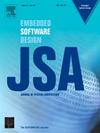尖峰通信优化的硬件/软件协同设计:利用神经元级通信模式
IF 4.1
2区 计算机科学
Q1 COMPUTER SCIENCE, HARDWARE & ARCHITECTURE
引用次数: 0
摘要
神经形态硬件是专门设计用于加速峰值神经网络(SNN)计算的,通过通过片上网络(NoC)基础设施相互连接的多个计算核心。然而,脉冲通信已经成为一个重要的瓶颈,限制了神经形态系统的整体性能。通过分析snn的通信特性,我们确定了两种主要的神经元级通信模式:空间一致的局部通信和多对同通信。为了解决这些挑战,我们提出了一个协同优化框架,其中包括:(1)在软件层面,我们利用空间一致的本地通信引入一种新的跨层拓扑排序算法,该算法改进了初始SNN的放置,随后使用轻量级微调算法进一步优化放置;(2)在硬件层面,受多对同通信的启发,我们引入了一种新的峰值事件合并路由机制,该机制将多个峰值事件合并到统一的数据包中,通过数据包聚合有效地降低了NoC流量密度。对六个SNN基准的综合评估表明,在通信延迟和能耗方面有了显著改善。本文章由计算机程序翻译,如有差异,请以英文原文为准。
Hardware/Software Co-design for spike communication optimization: Leveraging neuron-level communication patterns
Neuromorphic hardware is specifically designed to accelerate Spiking Neural Network (SNN) computations through multiple computing cores interconnected via network-on-chip (NoC) infrastructure. However, spike communication has emerged as a significant bottleneck, limiting the overall performance of neuromorphic systems. By analyzing the communication characteristics of SNNs, we identify two dominant neuron-level communication patterns: spatially consistent local communication and many-to-same communication. To address these challenges, we present a co-optimization framework comprising (1) at the software level, we leverage the spatially consistent local communication to introduce a novel cross-layer topological sorting algorithm, which improves the initial SNN placement, followed by a lightweight fine-tuning algorithm to further optimize the placement, and (2) at the hardware level, inspired by the many-to-same communication, we introduce a novel spike event merge routing mechanism that consolidates multiple spike events into unified packets, effectively reducing NoC traffic density through packet aggregation. Comprehensive evaluation across six SNN benchmarks demonstrates significant improvements in communication latency and energy consumption.
求助全文
通过发布文献求助,成功后即可免费获取论文全文。
去求助
来源期刊

Journal of Systems Architecture
工程技术-计算机:硬件
CiteScore
8.70
自引率
15.60%
发文量
226
审稿时长
46 days
期刊介绍:
The Journal of Systems Architecture: Embedded Software Design (JSA) is a journal covering all design and architectural aspects related to embedded systems and software. It ranges from the microarchitecture level via the system software level up to the application-specific architecture level. Aspects such as real-time systems, operating systems, FPGA programming, programming languages, communications (limited to analysis and the software stack), mobile systems, parallel and distributed architectures as well as additional subjects in the computer and system architecture area will fall within the scope of this journal. Technology will not be a main focus, but its use and relevance to particular designs will be. Case studies are welcome but must contribute more than just a design for a particular piece of software.
Design automation of such systems including methodologies, techniques and tools for their design as well as novel designs of software components fall within the scope of this journal. Novel applications that use embedded systems are also central in this journal. While hardware is not a part of this journal hardware/software co-design methods that consider interplay between software and hardware components with and emphasis on software are also relevant here.
 求助内容:
求助内容: 应助结果提醒方式:
应助结果提醒方式:


